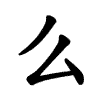么
Appearance
| ||||||||
Translingual
[edit]| Stroke order | |||
|---|---|---|---|

| |||
Han character
[edit]么 (Kangxi radical 4, 丿+2, 3 strokes, cangjie input 竹戈 (HI), four-corner 20732, composition ⿱丿厶)
Derived characters
[edit]References
[edit]- Kangxi Dictionary: page 82, character 3
- Dai Kanwa Jiten: character 121
- Dae Jaweon: page 165, character 9
- Hanyu Da Zidian (first edition): volume 1, page 33, character 2
- Unihan data for U+4E48
Chinese
[edit]Etymology 1
[edit]Glyph origin
[edit]Variant of 幺.
Definitions
[edit]| For pronunciation and definitions of 么 – see 幺 (“tiny; minute; youngest; etc.”). (This character is a variant form of 幺). |
Etymology 2
[edit]Glyph origin
[edit]Simplified from 麽 (elimination of 麻). Officially adopted as the simplified form of 麽 in the Chinese Character Simplification Scheme (《漢字簡化方案》) in 1956.
Definitions
[edit]| For pronunciation and definitions of 么 – see 麼. (This character is the simplified form of 麼). |
Notes:
|
Usage notes
[edit]麼 or 麽 is written as 么 and 麽 in simplified Chinese depending on the meaning. See 麼 to learn more.
Japanese
[edit]Kanji
[edit]么
- This term needs a translation to English. Please help out and add a translation, then remove the text
{{rfdef}}.
Readings
[edit]Compounds
[edit]Usage notes
[edit]Korean
[edit]Hanja
[edit]么 • (yo) (hangeul 요, revised yo, McCune–Reischauer yo)
- This term needs a translation to English. Please help out and add a translation, then remove the text
{{rfdef}}.
Categories:
- CJK Unified Ideographs block
- Han script characters
- Translingual lemmas
- Translingual symbols
- Chinese numeral symbols
- Chinese numerals
- Chinese lemmas
- Mandarin lemmas
- Sichuanese lemmas
- Cantonese lemmas
- Hakka lemmas
- Hokkien lemmas
- Teochew lemmas
- Wu lemmas
- Middle Chinese lemmas
- Old Chinese lemmas
- Chinese hanzi
- Mandarin hanzi
- Sichuanese hanzi
- Cantonese hanzi
- Hakka hanzi
- Hokkien hanzi
- Teochew hanzi
- Wu hanzi
- Middle Chinese hanzi
- Old Chinese hanzi
- Chinese adjectives
- Mandarin adjectives
- Sichuanese adjectives
- Cantonese adjectives
- Hakka adjectives
- Hokkien adjectives
- Teochew adjectives
- Wu adjectives
- Middle Chinese adjectives
- Old Chinese adjectives
- Chinese nouns
- Mandarin nouns
- Sichuanese nouns
- Cantonese nouns
- Hakka nouns
- Hokkien nouns
- Teochew nouns
- Wu nouns
- Middle Chinese nouns
- Old Chinese nouns
- Chinese proper nouns
- Mandarin proper nouns
- Sichuanese proper nouns
- Cantonese proper nouns
- Hakka proper nouns
- Hokkien proper nouns
- Teochew proper nouns
- Wu proper nouns
- Middle Chinese proper nouns
- Old Chinese proper nouns
- Chinese terms spelled with 么
- Chinese variant forms
- CJKV simplified characters
- Chinese particles
- Mandarin particles
- Cantonese particles
- Chinese suffixes
- Mandarin suffixes
- Cantonese suffixes
- Chinese simplified forms
- Japanese kanji
- Japanese hyōgai kanji
- Japanese kanji with goon reading よう
- Japanese kanji with historical goon reading えう
- Japanese kanji with kan'on reading よう
- Japanese kanji with historical kan'on reading えう
- Korean lemmas
- Korean hanja
- CJKV simplified characters which already existed as traditional characters
